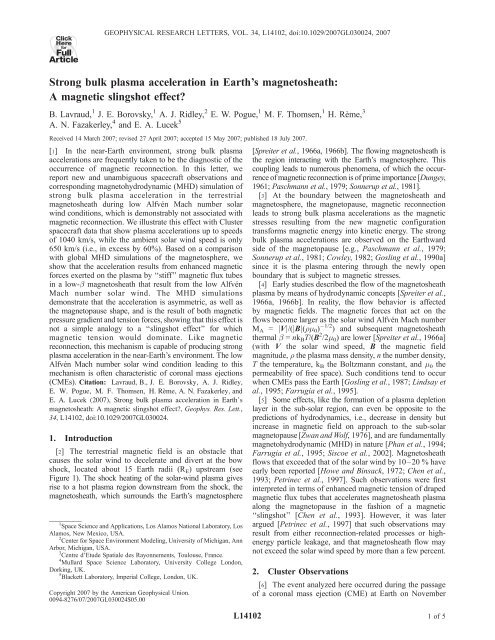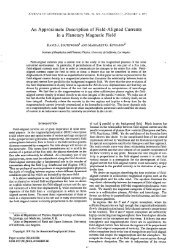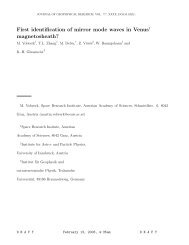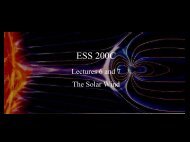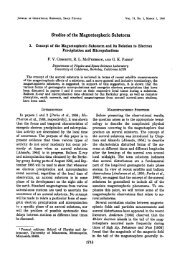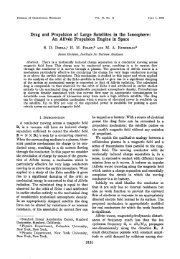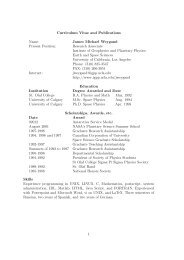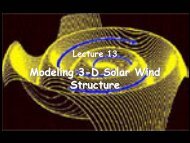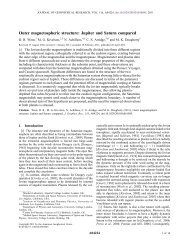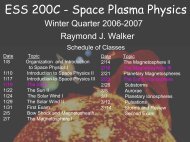A magnetic slingshot effect? - Institute of Geophysics and Planetary ...
A magnetic slingshot effect? - Institute of Geophysics and Planetary ...
A magnetic slingshot effect? - Institute of Geophysics and Planetary ...
You also want an ePaper? Increase the reach of your titles
YUMPU automatically turns print PDFs into web optimized ePapers that Google loves.
Click<br />
Here<br />
for<br />
Full<br />
Article<br />
Strong bulk plasma acceleration in Earth’s magnetosheath:<br />
A <strong>magnetic</strong> <strong>slingshot</strong> <strong>effect</strong>?<br />
B. Lavraud, 1 J. E. Borovsky, 1 A. J. Ridley, 2 E. W. Pogue, 1 M. F. Thomsen, 1 H. Rème, 3<br />
A. N. Fazakerley, 4 <strong>and</strong> E. A. Lucek 5<br />
Received 14 March 2007; revised 27 April 2007; accepted 15 May 2007; published 18 July 2007.<br />
[1] In the near-Earth environment, strong bulk plasma<br />
accelerations are frequently taken to be the diagnostic <strong>of</strong> the<br />
occurrence <strong>of</strong> <strong>magnetic</strong> reconnection. In this letter, we<br />
report new <strong>and</strong> unambiguous spacecraft observations <strong>and</strong><br />
corresponding magnetohydrodynamic (MHD) simulation <strong>of</strong><br />
strong bulk plasma acceleration in the terrestrial<br />
magnetosheath during low Alfvén Mach number solar<br />
wind conditions, which is demonstrably not associated with<br />
<strong>magnetic</strong> reconnection. We illustrate this <strong>effect</strong> with Cluster<br />
spacecraft data that show plasma accelerations up to speeds<br />
<strong>of</strong> 1040 km/s, while the ambient solar wind speed is only<br />
650 km/s (i.e., in excess by 60%). Based on a comparison<br />
with global MHD simulations <strong>of</strong> the magnetosphere, we<br />
show that the acceleration results from enhanced <strong>magnetic</strong><br />
forces exerted on the plasma by ‘‘stiff’’ <strong>magnetic</strong> flux tubes<br />
in a low-b magnetosheath that result from the low Alfvén<br />
Mach number solar wind. The MHD simulations<br />
demonstrate that the acceleration is asymmetric, as well as<br />
the magnetopause shape, <strong>and</strong> is the result <strong>of</strong> both <strong>magnetic</strong><br />
pressure gradient <strong>and</strong> tension forces, showing that this <strong>effect</strong> is<br />
not a simple analogy to a ‘‘<strong>slingshot</strong> <strong>effect</strong>’’ for which<br />
<strong>magnetic</strong> tension would dominate. Like <strong>magnetic</strong><br />
reconnection, this mechanism is capable <strong>of</strong> producing strong<br />
plasma acceleration in the near-Earth’s environment. The low<br />
Alfvén Mach number solar wind condition leading to this<br />
mechanism is <strong>of</strong>ten characteristic <strong>of</strong> coronal mass ejections<br />
(CMEs). Citation: Lavraud, B., J. E. Borovsky, A. J. Ridley,<br />
E. W. Pogue, M. F. Thomsen, H. Rème, A. N. Fazakerley, <strong>and</strong><br />
E. A. Lucek (2007), Strong bulk plasma acceleration in Earth’s<br />
magnetosheath: A <strong>magnetic</strong> <strong>slingshot</strong> <strong>effect</strong>?, Geophys. Res. Lett.,<br />
34, L14102, doi:10.1029/2007GL030024.<br />
1. Introduction<br />
GEOPHYSICAL RESEARCH LETTERS, VOL. 34, L14102, doi:10.1029/2007GL030024, 2007<br />
[2] The terrestrial <strong>magnetic</strong> field is an obstacle that<br />
causes the solar wind to decelerate <strong>and</strong> divert at the bow<br />
shock, located about 15 Earth radii (R E) upstream (see<br />
Figure 1). The shock heating <strong>of</strong> the solar-wind plasma gives<br />
rise to a hot plasma region downstream from the shock, the<br />
magnetosheath, which surrounds the Earth’s magnetosphere<br />
1<br />
Space Science <strong>and</strong> Applications, Los Alamos National Laboratory, Los<br />
Alamos, New Mexico, USA.<br />
2<br />
Center for Space Environment Modeling, University <strong>of</strong> Michigan, Ann<br />
Arbor, Michigan, USA.<br />
3<br />
Centre d’Etude Spatiale des Rayonnements, Toulouse, France.<br />
4<br />
Mullard Space Science Laboratory, University College London,<br />
Dorking, UK.<br />
5<br />
Blackett Laboratory, Imperial College, London, UK.<br />
Copyright 2007 by the American Geophysical Union.<br />
0094-8276/07/2007GL030024$05.00<br />
[Spreiter et al., 1966a, 1966b]. The flowing magnetosheath is<br />
the region interacting with the Earth’s magnetosphere. This<br />
coupling leads to numerous phenomena, <strong>of</strong> which the occurrence<br />
<strong>of</strong> <strong>magnetic</strong> reconnection is <strong>of</strong> prime importance [Dungey,<br />
1961; Paschmann et al., 1979; Sonnerup et al., 1981].<br />
[3] At the boundary between the magnetosheath <strong>and</strong><br />
magnetosphere, the magnetopause, <strong>magnetic</strong> reconnection<br />
leads to strong bulk plasma accelerations as the <strong>magnetic</strong><br />
stresses resulting from the new <strong>magnetic</strong> configuration<br />
transforms <strong>magnetic</strong> energy into kinetic energy. The strong<br />
bulk plasma accelerations are observed on the Earthward<br />
side <strong>of</strong> the magnetopause [e.g., Paschmann et al., 1979;<br />
Sonnerup et al., 1981; Cowley, 1982; Gosling et al., 1990a]<br />
since it is the plasma entering through the newly open<br />
boundary that is subject to <strong>magnetic</strong> stresses.<br />
[4] Early studies described the flow <strong>of</strong> the magnetosheath<br />
plasma by means <strong>of</strong> hydrodynamic concepts [Spreiter et al.,<br />
1966a, 1966b]. In reality, the flow behavior is affected<br />
by <strong>magnetic</strong> fields. The <strong>magnetic</strong> forces that act on the<br />
flows become larger as the solar wind Alfvén Mach number<br />
MA = jVj/(jBj(rm0) 1/2 ) <strong>and</strong> subsequent magnetosheath<br />
thermal b = nkBT/(B 2 /2m0) are lower [Spreiter et al., 1966a]<br />
(with V the solar wind speed, B the <strong>magnetic</strong> field<br />
magnitude, r the plasma mass density, n the number density,<br />
T the temperature, kB the Boltzmann constant, <strong>and</strong> m0 the<br />
permeability <strong>of</strong> free space). Such conditions tend to occur<br />
when CMEs pass the Earth [Gosling et al., 1987; Lindsay et<br />
al., 1995; Farrugia et al., 1995].<br />
[5] Some <strong>effect</strong>s, like the formation <strong>of</strong> a plasma depletion<br />
layer in the sub-solar region, can even be opposite to the<br />
predictions <strong>of</strong> hydrodynamics, i.e., decrease in density but<br />
increase in <strong>magnetic</strong> field on approach to the sub-solar<br />
magnetopause [Zwan <strong>and</strong> Wolf, 1976], <strong>and</strong> are fundamentally<br />
magnetohydrodynamic (MHD) in nature [Phan et al., 1994;<br />
Farrugia et al., 1995; Siscoe et al., 2002]. Magnetosheath<br />
flows that exceeded that <strong>of</strong> the solar wind by 10–20 % have<br />
early been reported [Howe <strong>and</strong> Binsack, 1972; Chen et al.,<br />
1993; Petrinec et al., 1997]. Such observations were first<br />
interpreted in terms <strong>of</strong> enhanced <strong>magnetic</strong> tension <strong>of</strong> draped<br />
<strong>magnetic</strong> flux tubes that accelerates magnetosheath plasma<br />
along the magnetopause in the fashion <strong>of</strong> a <strong>magnetic</strong><br />
‘‘<strong>slingshot</strong>’’ [Chen et al., 1993]. However, it was later<br />
argued [Petrinec et al., 1997] that such observations may<br />
result from either reconnection-related processes or highenergy<br />
particle leakage, <strong>and</strong> that magnetosheath flow may<br />
not exceed the solar wind speed by more than a few percent.<br />
2. Cluster Observations<br />
[6] The event analyzed here occurred during the passage<br />
<strong>of</strong> a coronal mass ejection (CME) at Earth on November<br />
L14102 1 <strong>of</strong> 5
L14102 LAVRAUD ET AL.: STRONG ACCELERATION IN THE MAGNETOSHEATH L14102<br />
Figure 1. (a) X-Y plane 2D cut <strong>of</strong> the bulk plasma speed (with same color palette as Figure 1b) after two hours <strong>of</strong> global<br />
MHD simulation for the steady conditions defined as run 1 in the text, i.e., for a low Alfvén Mach number solar wind. A<br />
flow streamline passing in the large plasma flow region, <strong>and</strong> used in section 4, is shown with a black dashed line. The solar<br />
wind flows from the Sun (right side) <strong>and</strong> the bow shock <strong>and</strong> magnetopause are illustrated. (b) Y-Z plane 2D cut <strong>of</strong> the<br />
plasma speed for the same run at a downtail distance X = 5 R E. Cluster 1 location (projection) at 9 UT on November 25th<br />
2001, i.e., during similar solar wind conditions, is shown with black diamonds.<br />
25th, 2001. The CME has been identified as a <strong>magnetic</strong><br />
cloud [Cane <strong>and</strong> Richardson, 2003]. Around 09:00 UT on<br />
that day the four Cluster spacecraft were located at ( 3.4,<br />
18.0, 5.2) Earth Radii (RE; GSM coordinates) on the<br />
dusk-side southern flank <strong>of</strong> the magnetosphere near the<br />
dawn-dusk terminator (see Figure 1). Figure 2 shows<br />
Cluster 1 data <strong>and</strong> ACE solar wind conditions (lagged by<br />
2400 s) for the interval 09:00 – 09:30 UT. During this<br />
interval, the interplanetary <strong>magnetic</strong> field (IMF) is strongly<br />
northward (Figure 2h), the solar wind velocity is about<br />
650 km/s (Figure 2c), <strong>and</strong> both are steady for several hours<br />
outside <strong>of</strong> the interval shown here. At around 9:15 UT the<br />
density (Figure 2g) increases to 5 cm 3 ; this produces a<br />
compression <strong>of</strong> the magnetosphere <strong>and</strong> Cluster crosses the<br />
magnetopause (vertical dashed line in Figure 2) <strong>and</strong> enters the<br />
magnetosheath from the magnetosphere. The Alfvén Mach<br />
number (MA) <strong>of</strong> the solar wind is low during this interval:<br />
MA = 2.0 before the density jump <strong>and</strong> 4.4 after, which<br />
compares to MA 8 or more for regular solar wind conditions.<br />
[7] Upon entering the magnetosheath, very large flows<br />
are observed by the three operating ion instruments onboard<br />
the spacecraft, up to 1040 km/s on two <strong>of</strong> them, while the<br />
solar wind speed is only 650 km/s (Figure 2c). These flows<br />
are mainly perpendicular to the <strong>magnetic</strong> field (Figure 2d)<br />
<strong>and</strong> the flowing magnetosheath plasma is characterized by a<br />
thermal b much lower than unity (Figure 2f), which is<br />
expected for low MA solar wind [Farrugia et al., 1995].<br />
[8] While such large plasma acceleration is <strong>of</strong>ten taken to<br />
be the signature <strong>of</strong> <strong>magnetic</strong> reconnection, several arguments<br />
demonstrate that this is not the case here. First,<br />
Cluster <strong>magnetic</strong> field data (Figure 2e) show a clear current<br />
sheet discontinuity at 09:12:30 UT, as is typically observed<br />
for crossings <strong>of</strong> the magnetopause current layer. Secondly,<br />
this <strong>magnetic</strong> discontinuity also corresponds to a discontinuity<br />
in the energy flux spectrograms <strong>of</strong> both ions (Figure 2b)<br />
<strong>and</strong> electrons (Figure 2a), with the fluxes <strong>of</strong> high energy<br />
electrons around 1 keV dropping tremendously right at the<br />
boundary before the flows are detected. This latter characteristic<br />
corresponds to a drop in electron (<strong>and</strong> ion) temper-<br />
2 <strong>of</strong> 5<br />
ature. High energy electrons (>1 keV) are extremely fast<br />
(much faster than the bulk flow speed). The lack <strong>of</strong> such<br />
electrons in the large flow region demonstrates that this<br />
region is not <strong>magnetic</strong>ally connected to the magnetosphere<br />
(where such electrons are present, as seen before 09:15 UT),<br />
<strong>and</strong> thus that the flows cannot be the result <strong>of</strong> particle<br />
leakage. These observations thus also constitute an unambiguous<br />
pro<strong>of</strong> that Cluster is outside the magnetopause<br />
when the fast flows are detected [Gosling et al., 1990b;<br />
Fuselier et al., 1997; Lavraud et al., 2006]. Because<br />
<strong>magnetic</strong> reconnection leads to enhanced flows inside the<br />
magnetopause [Paschmann et al., 1979; Cowley, 1982],<br />
these flows are not the result <strong>of</strong> <strong>magnetic</strong> reconnection.<br />
[9] Because <strong>of</strong> the solar wind density jump around<br />
09:15 UT, the magnetopause crossing is extremely rapid.<br />
Using a multi-spacecraft discontinuity analysis technique<br />
[Dunlop et al., 2002], we determine a lower limit for the<br />
magnetopause normal speed <strong>of</strong> 400 km/s for this crossing.<br />
This result means, although the enhanced flows are largest<br />
close to the magnetopause <strong>and</strong> recorded for a rather short<br />
period, that this flow layer extends to some distance away<br />
from the magnetopause. This dynamic crossing led the<br />
spacecraft to rapidly scan the magnetosheath pr<strong>of</strong>ile,<br />
possibly over more than ten RE in a few minutes.<br />
3. Global MHD Simulations<br />
[10] BATS-R-US is a 3-D global MHD model <strong>of</strong> the solar<br />
wind-magnetosphere-ionosphere interaction [Gombosi et<br />
al., 2000; Ridley et al., 2004]. The model is based on the<br />
equations <strong>of</strong> ideal single-fluid MHD. These equations are<br />
solved on a three-dimensional grid wherein the cell size<br />
increases away from Earth.<br />
[11] To illustrate the physics <strong>of</strong> the mechanism that<br />
results in large magnetosheath flows, we made two runs<br />
<strong>of</strong> the global MHD model with steady solar wind parameters.<br />
Run 1 corresponds to a low M A ( 2) with solar wind<br />
conditions corresponding to those during the interval 09:00 –<br />
09:15 UT with n = 1 cm 3 , jVj = 650 km/s <strong>and</strong> IMF B Z = 15
L14102 LAVRAUD ET AL.: STRONG ACCELERATION IN THE MAGNETOSHEATH L14102<br />
Figure 2. Cluster 1 <strong>and</strong> ACE data for the magnetopause<br />
crossing on November 25th, 2001. The vertical dashed line<br />
shows the magnetopause. (a) Cluster omni-directional<br />
electron spectrogram. (b) Cluster omni-directional ion<br />
spectrogram. (c) Cluster GSM ion velocity components,<br />
together with ACE solar wind bulk speed (green). (d) Cluster<br />
parallel <strong>and</strong> perpendicular components <strong>of</strong> the velocity.<br />
(e) Cluster GSM <strong>magnetic</strong> field components. (f) Cluster<br />
thermal b (ratio <strong>of</strong> thermal to <strong>magnetic</strong> pressures).<br />
(g) Cluster ion density <strong>and</strong> temperature, together with<br />
ACE solar wind density. (h) ACE GSM IMF components.<br />
Solar wind data are lagged by 2400 s to account for<br />
advection from ACE to the Earth. The magnetosphere is to<br />
the left <strong>of</strong> the magnetopause <strong>and</strong> the magnetosheath to the<br />
right. This crossing shows the occurrence <strong>of</strong> intense flows<br />
outside the magnetopause in the magnetosheath.<br />
nT. Run 2 corresponds to more typical solar wind conditions<br />
with n = 5 cm 3 , jVj = 650 km/s <strong>and</strong> IMF B Z = 5 nT. Figure<br />
1a shows a cut in the equatorial X-Y GSM plane <strong>of</strong> the bulk<br />
speed from run 1, together with the Cluster 1 location at<br />
09:00 UT on November 25th, 2001 for context.<br />
[12] Figure 1a shows two layers <strong>of</strong> large flows along the<br />
flanks <strong>of</strong> the magnetosphere, to speeds higher than 850 km/s.<br />
Such speeds are substantially higher than the input solar<br />
wind speed <strong>of</strong> 650 km/s. Although not shown, the large<br />
3 <strong>of</strong> 5<br />
flow regions in run 1 are characterized by slightly hotter <strong>and</strong><br />
less dense plasma as compared to the magnetosheath further<br />
from the magnetopause. These MHD results are thus<br />
compatible with Cluster measurements close to the dusk<br />
magnetopause during the interval <strong>of</strong> November 25th, 2001<br />
when comparable solar wind conditions prevailed. However,<br />
it is noted that the flow exceeds that <strong>of</strong> the solar wind by<br />
more than 30% in the simulation while the acceleration<br />
observed by Cluster for similar solar wind conditions<br />
exceeds that <strong>of</strong> the solar wind by up to 60%. The reasons<br />
for such a quantitative difference will deserve future investigations<br />
(see section 5).<br />
[13] Figure 1b shows a cut in the Y-ZGSM plane at XGSM =<br />
5 RE <strong>of</strong> the plasma speed from run 1. A comparison <strong>of</strong><br />
Figures 1a <strong>and</strong> 1b shows that plasma acceleration is<br />
asymmetric with the high speeds observed along the dawn<br />
<strong>and</strong> dusk flanks <strong>and</strong> lower speeds observed over the poles.<br />
In addition, the magnetosphere (i.e., magnetopause) appears<br />
elongated in the North-South direction. As detailed below,<br />
this asymmetry in both the flows <strong>and</strong> magnetopause shape<br />
may be expected since <strong>magnetic</strong> forces act perpendicular to<br />
the <strong>magnetic</strong> field. Under the prevailing northward IMF, the<br />
strongest <strong>magnetic</strong> forces are expected along the flanks. As<br />
the IMF rotates, the location <strong>of</strong> flow enhancement <strong>and</strong> the<br />
magnetopause elongation follow the rotation so that for<br />
more horizontal IMF the large flows are located over the<br />
poles <strong>of</strong> the magnetosphere <strong>and</strong> the magnetopause is elongated<br />
in the dawn-dusk direction. Such cases have been<br />
found but are not shown here <strong>and</strong> left for a more exhaustive<br />
study <strong>of</strong> low Mach number <strong>effect</strong>s on solar wind –<br />
magnetosphere coupling (cf. section 5).<br />
4. Interplay Between MHD Forces<br />
[14] To investigate the possible <strong>magnetic</strong> <strong>slingshot</strong> nature<br />
<strong>of</strong> this acceleration, we make use <strong>of</strong> MHD runs 1 <strong>and</strong> 2 in<br />
Figure 3. From each simulation, we have selected a magnetosheath<br />
flow streamline that passes in the dusk-flank<br />
magnetosheath, such as illustrated in Figure 1a for run 1.<br />
[15] It is first noted that the bow shock, indicated in both<br />
cases by a sharp deceleration (Figures 3a <strong>and</strong> 3d), is located<br />
further from the Earth in the low MA case although the<br />
dynamic pressure is lower for this simulation. As explained<br />
by Russell <strong>and</strong> Petrinec [1996], the bow shock intuitively<br />
ought to retreat Sunward as the solar wind Mach numbers<br />
approach 1 (both Alfvénic (MA) <strong>and</strong> magnetosonic (M),<br />
with MA > M).<br />
[16] Figure 3 displays the accelerations resulting from the<br />
MHD forces at work <strong>and</strong> the speed pr<strong>of</strong>ile along the<br />
streamlines selected for each run. The acceleration due to<br />
each force is simply calculated along the streamlines<br />
according to the steady state MHD momentum equation<br />
(equation 1).<br />
rðV rÞV<br />
¼ rp þ J B ð1Þ<br />
J B ¼ 1<br />
ðB rÞB<br />
r B2<br />
m 0<br />
2m 0<br />
@V<br />
@s ¼ Arp þ ArB þ ACurvB<br />
ð2Þ<br />
ð3Þ
L14102 LAVRAUD ET AL.: STRONG ACCELERATION IN THE MAGNETOSHEATH L14102<br />
Figure 3. Analysis <strong>of</strong> global MHD results from the two<br />
runs described in the text, i.e., respectively with a high-<br />
(top) <strong>and</strong> low- (bottom) Alfvén Mach number (MA) solar<br />
wind. (a, d) The speed pr<strong>of</strong>ile along the streamlines from the<br />
simulations (solid). (b, e) The accelerations due to <strong>magnetic</strong><br />
forces (from the total J B force (solid) <strong>and</strong> from the<br />
<strong>magnetic</strong> pressure gradient force only (dashed)). (c, f) The<br />
accelerations due to plasma pressure gradient forces. We<br />
observe that most <strong>of</strong> the acceleration comes from plasma<br />
pressure gradient forces in the high MA case, while most <strong>of</strong> the<br />
acceleration comes from <strong>magnetic</strong> forces in the low MA case.<br />
[17] In equation 1, the J B term is the total <strong>magnetic</strong><br />
force, which can be divided into <strong>magnetic</strong> tension <strong>and</strong><br />
pressure gradient terms as shown in equation 2. The<br />
<strong>magnetic</strong> tension force (first term on right-h<strong>and</strong> side<br />
(RHS) <strong>of</strong> equation 2) includes a term that nullifies the<br />
parallel (to the <strong>magnetic</strong> field) component <strong>of</strong> the <strong>magnetic</strong><br />
pressure gradient force (second term on RHS), so that the<br />
total <strong>magnetic</strong> force only acts perpendicular to the <strong>magnetic</strong><br />
field. We have reconstructed in Figure 3 the perpendicular<br />
accelerations, resulting from each <strong>of</strong> the three MHD forces<br />
that act along the selected streamlines, as illustrated in<br />
equation 3. In addition to parameters defined previously,<br />
J is the current density, @s is a length element along the<br />
streamline, <strong>and</strong> the three RHS terms <strong>of</strong> equation 3 are,<br />
4 <strong>of</strong> 5<br />
respectively from left to right, the acceleration due to<br />
plasma pressure gradient forces (Figures 3c <strong>and</strong> 3f), <strong>magnetic</strong><br />
pressure gradient forces <strong>and</strong> <strong>magnetic</strong> tension forces<br />
(Figures 3b <strong>and</strong> 3e). Also, it is known that derivatives are<br />
<strong>of</strong>ten noisy in numerical calculations [e.g., Issacson <strong>and</strong><br />
Keller, 1966]. Prior to analysis, streamline data have been<br />
smoothed (ten-point running average) for sake <strong>of</strong> cleanliness,<br />
but this does not affect the main results.<br />
[18] Figure 3 shows that for the high MA case (Figures 3a,<br />
3b, <strong>and</strong> 3c), the <strong>magnetic</strong> forces are very low <strong>and</strong> the plasma<br />
pressure gradient forces are dominant. The resulting acceleration<br />
is gradual so that the magnetosheath flow increases<br />
without attaining speeds larger than that <strong>of</strong> the solar wind<br />
itself (for the spatial domain concerned). For the low MA<br />
case (Figures 3d, 3e, <strong>and</strong> 3f), the <strong>magnetic</strong> forces are<br />
dominant <strong>and</strong> lead to very strong acceleration up to speeds<br />
substantially larger than the solar wind.<br />
[19] In the low MA case, when integrating the acceleration<br />
resulting from each force in the region between 40 RE<br />
to 20 RE (i.e., from the maximum <strong>of</strong> the flows to just<br />
inside the bow shock), one finds that the acceleration owing<br />
to the <strong>magnetic</strong> pressure gradient force represents 49% <strong>of</strong><br />
the total acceleration, while the <strong>magnetic</strong> tension <strong>and</strong><br />
plasma pressure gradient accelerations represent 43%<br />
<strong>and</strong> 8%, respectively. These ratios tend to vary as follows:<br />
(1) the tension force is more important for streamlines closer<br />
to the magnetopause, <strong>and</strong> (2) the <strong>magnetic</strong> pressure gradient<br />
force is more dominant as one starts the integration <strong>of</strong> forces<br />
further downstream <strong>of</strong> the shock. The latter is due to the fact<br />
that, in the subsolar magnetosheath, the <strong>magnetic</strong> pressure<br />
builds up toward the magnetopause, thus acting against the<br />
acceleration. Past the point <strong>of</strong> maximum <strong>magnetic</strong> pressure,<br />
the <strong>magnetic</strong> pressure gradient force becomes large <strong>and</strong><br />
dominant (see Figure 3e). In conclusion, the acceleration<br />
due to the <strong>magnetic</strong> pressure gradient force is globally<br />
comparable to that from the <strong>magnetic</strong> tension force. This<br />
acceleration mechanism is not a simple analogy to a<br />
<strong>slingshot</strong> <strong>effect</strong> [Chen et al., 1993], for which the<br />
acceleration ought to be due, at least predominantly, to the<br />
<strong>magnetic</strong> tension force.<br />
[20] We have used idealized steady-state conditions for the<br />
purpose <strong>of</strong> easily identifying <strong>and</strong> studying individual MHD<br />
forces along given streamlines. However, it must be mentioned<br />
that non-steady-state <strong>and</strong> non-ideal-MHD <strong>effect</strong>s, as<br />
well as geophysical parameters like the dipole tilt <strong>and</strong> ionospheric<br />
conductivity (e.g., by influencing dayside/lobe<br />
reconnection <strong>and</strong> thus <strong>magnetic</strong> field pile-up at the dayside),<br />
may have important consequences that may for instance<br />
explain the difference in flow magnitude between simulations<br />
<strong>and</strong> observations. Such investigation is left for future studies.<br />
5. Conclusion<br />
[21] The present results provide new <strong>and</strong> unambiguous<br />
pro<strong>of</strong> <strong>of</strong> the occurrence <strong>of</strong> strong bulk flow accelerations in<br />
the near-Earth environment that is demonstrably not the<br />
result <strong>of</strong> <strong>magnetic</strong> reconnection. The enhanced <strong>magnetic</strong><br />
forces in the magnetosheath also deform the magnetopause<br />
shape, which likely alters the modes <strong>of</strong> interaction <strong>and</strong><br />
penetration <strong>of</strong> the solar wind plasma. The increased velocity<br />
shear at the flank magnetopause may help the development<br />
<strong>of</strong> Kelvin-Helmholtz waves, but on the other h<strong>and</strong> the
L14102 LAVRAUD ET AL.: STRONG ACCELERATION IN THE MAGNETOSHEATH L14102<br />
enhanced <strong>magnetic</strong> fields may stabilize the process. Future<br />
studies should focus on how this mechanism may affect<br />
solar wind plasma entry into the magnetosphere [Chen et<br />
al., 1993; Hasegawa et al., 2004].<br />
[22] The driving conditions are a low MA solar wind <strong>and</strong><br />
subsequent low-b magnetosheath, which is <strong>of</strong>ten typical <strong>of</strong><br />
CMEs [Gosling et al., 1987; Lindsay et al., 1995; Farrugia<br />
et al., 1995]. The <strong>effect</strong>s described here thus condition the<br />
magnetosheath-magnetosphere interaction during the passage<br />
<strong>of</strong> such structures at Earth. Under southward IMF,<br />
<strong>magnetic</strong> field pile-up at the dayside magnetopause is lower<br />
owing to the occurrence <strong>of</strong> dayside <strong>magnetic</strong> reconnection.<br />
Yet the entire magnetosheath is characterized by unusually<br />
low-b plasma during such solar wind conditions. Thus,<br />
although likely weaker under southward, in future studies<br />
we will investigate whether these <strong>effect</strong>s may occur during<br />
the development <strong>of</strong> some CME-driven geo<strong>magnetic</strong> storms.<br />
[23] Acknowledgments. The authors are grateful to T. I. Pulkkinen,<br />
R. M. Skoug, J. Raeder, <strong>and</strong> C. Goodrich for comments. We are grateful to<br />
the Community Coordinated Modeling Center (CCMC) for the use <strong>of</strong><br />
models, <strong>and</strong> to the ACE teams for the use <strong>of</strong> solar wind data. Work at Los<br />
Alamos was performed under the auspices <strong>of</strong> the US Department <strong>of</strong> Energy,<br />
with support from NASA programs (Guest investigator <strong>and</strong> Living With a<br />
Star TR&T).<br />
References<br />
Cane, H. V., <strong>and</strong> I. G. Richardson (2003), Interplanetary coronal mass<br />
ejections in the near-Earth solar wind during 1996–2002, J. Geophys.<br />
Res., 108(A4), 1156, doi:10.1029/2002JA009817.<br />
Chen, S.-H., M. G. Kivelson, J. T. Gosling, R. J. Walker, <strong>and</strong> A. J. Lazarus<br />
(1993), Anomalous aspects <strong>of</strong> magnetosheath flow <strong>and</strong> <strong>of</strong> the shape <strong>and</strong><br />
oscillations <strong>of</strong> the magnetopause during an interval <strong>of</strong> strongly northward<br />
interplanetary <strong>magnetic</strong> field, J. Geophys. Res., 98(A4), 5727–5742.<br />
Cowley, S. W. H. (1982), The causes <strong>of</strong> convection in the Earth’s magnetosphere:<br />
A review <strong>of</strong> developments during the IMS, Rev. Geophys., 20(3),<br />
531–565.<br />
Dungey, J. W. (1961), Interplanetary <strong>magnetic</strong> field <strong>and</strong> the auroral zones,<br />
Phys. Rev. Lett., 6, 47–48.<br />
Dunlop, M. W., A. Balogh, <strong>and</strong> K.-H. Glassmeier (2002), Four-point Cluster<br />
application <strong>of</strong> <strong>magnetic</strong> field analysis tools: The discontinuity analyzer,<br />
J. Geophys. Res., 107(A11), 1385, doi:10.1029/2001JA005089.<br />
Farrugia, C. J., N. V. Erkaev, H. K. Biernat, <strong>and</strong> L. F. Burlaga (1995),<br />
Anomalous magnetosheath properties during Earth passage <strong>of</strong> an interplanetary<br />
<strong>magnetic</strong> cloud, J. Geophys. Res., 100(A10), 19,245–19,257.<br />
Fuselier, S. A., B. J. Anderson, <strong>and</strong> T. G. Onsager (1997), Electron <strong>and</strong> ion<br />
signatures <strong>of</strong> field line topology at the low-shear magnetopause, J. Geophys.<br />
Res., 102(A3), 4847–4863.<br />
Gombosi, T. I., et al. (2000), Multiscale MHD simulation <strong>of</strong> a coronal mass<br />
ejection <strong>and</strong> its interaction with the magnetosphere-ionosphere system,<br />
J. Atmos. Sol. Terr. Phys., 62(16), 1515– 1525.<br />
Gosling, J. T., D. N. Baker, S. J. Bame, W. C. Feldman, R. D. Zwickl, <strong>and</strong><br />
E. J. Smith (1987), Bidirectional solar wind electron heat flux events,<br />
J. Geophys. Res., 92(A8), 8519–8535.<br />
Gosling, J. T., M. F. Thomsen, S. J. Bame, R. C. Elphic, <strong>and</strong> C. T. Russell<br />
(1990a), Plasma flow reversals at the dayside magnetopause <strong>and</strong> the<br />
5 <strong>of</strong> 5<br />
origin <strong>of</strong> asymmetric polar cap convection, J. Geophys. Res., 95(A6),<br />
8073–8084.<br />
Gosling, J. T., M. F. Thomsen, S. J. Bame, T. G. Onsager, <strong>and</strong> C. T. Russell<br />
(1990b), The electron edge <strong>of</strong> the low latitude boundary layer during<br />
accelerated flow events, Geophys. Res. Lett., 17(11), 1833–1836.<br />
Hasegawa, H., et al. (2004), Rolled-up Kelvin-Helmholtz vortices <strong>and</strong><br />
associated solar wind entry at Earth’s magnetopause, Nature, 430,<br />
755–758.<br />
Howe, H. C., <strong>and</strong> J. H. Binsack (1972), Explorer 33 <strong>and</strong> 35 plasma<br />
observations <strong>of</strong> magnetosheath flow, J. Geophys. Res., 77(19), 3334–<br />
3344.<br />
Issacson, E., <strong>and</strong> H. B. Keller (1966), Analysis <strong>of</strong> Numerical Methods, John<br />
Wiley, New York.<br />
Lavraud, B., M. F. Thomsen, B. Lefebvre, S. J. Schwartz, K. Seki, T. D.<br />
Phan, Y. L. Wang, A. Fazakerley, H. Rème, <strong>and</strong> A. Balogh (2006),<br />
Evidence for newly closed magnetosheath field lines at the dayside magnetopause<br />
under northward IMF, J. Geophys. Res., 111, A05211,<br />
doi:10.1029/2005JA011266.<br />
Lindsay, G. M., C. T. Russell, <strong>and</strong> J. G. Luhmann (1995), Coronal mass<br />
ejection <strong>and</strong> stream interaction region characteristics <strong>and</strong> their potential<br />
geo<strong>magnetic</strong> <strong>effect</strong>iveness, J. Geophys. Res., 100(A9), 16,999–17,013.<br />
Paschmann, G., et al. (1979), Plasma acceleration at the Earth’s magnetopause:<br />
Evidence for reconnection, Nature, 282, 243–246.<br />
Petrinec, S. M., T. Mukai, A. Nishida, T. Yamamoto, T. K. Nakamura, <strong>and</strong><br />
S. Kokubun (1997), Geotail observations <strong>of</strong> magnetosheath flow near the<br />
magnetopause, using Wind as a solar wind monitor, J. Geophys. Res.,<br />
102(A12), 26,943–26,959.<br />
Phan, T.-D., G. Paschmann, W. Baumjohann, N. Sckopke, <strong>and</strong> H. Lühr<br />
(1994), The magnetosheath region adjacent to the dayside magnetopause:<br />
AMPTE/IRM observations, J. Geophys. Res., 99(A1), 121–141.<br />
Ridley, A. J., T. I. Gombosi, <strong>and</strong> D. L. DeZeeuw (2004), Ionospheric<br />
control <strong>of</strong> the magnetosphere: Conductance, Ann. Geophys., 22(2),<br />
567–584.<br />
Russell, C. T., <strong>and</strong> S. M. Petrinec (1996), Comments on ‘‘Towards an MHD<br />
theory for the st<strong>and</strong><strong>of</strong>f distance <strong>of</strong> Earth’s bow shock’’ by I. H. Cairns <strong>and</strong><br />
C. L. Grabbe, Geophys. Res. Lett., 23(3), 309–310.<br />
Siscoe, G. L., et al. (2002), MHD properties <strong>of</strong> magnetosheath flow, Planet.<br />
Space Sci., 50(5 –6), 461–471.<br />
Sonnerup, B. U. O., G. Paschmann, I. Papamastorakis, N. Sckopke,<br />
G. Haerendel, S. J. Bame, J. R. Asbridge, J. T. Gosling, <strong>and</strong> C. T. Russell<br />
(1981), Evidence for <strong>magnetic</strong> field reconnection at the Earth’s magnetopause,<br />
J. Geophys. Res., 86(A12), 10,049–10,067.<br />
Spreiter, J. R., A. L. Summers, <strong>and</strong> A. Y. Alksne (1966a), Hydro<strong>magnetic</strong><br />
flow around the magnetosphere, Planet. Space Sci., 14(11), 223–253.<br />
Spreiter, J. R., A. Y. Alksne, <strong>and</strong> B. Abraham-Shrauner (1966b), Theoretical<br />
proton velocity distributions in the flow around the magnetosphere,<br />
Planet. Space Sci., 14(11), 1207–1220.<br />
Zwan, B. J., <strong>and</strong> R. A. Wolf (1976), Depletion <strong>of</strong> solar wind plasma near a<br />
planetary boundary, J. Geophys. Res., 81(10), 1636–1648.<br />
J. E. Borovsky, B. Lavraud, E. W. Pogue, <strong>and</strong> M. F. Thomsen, Space<br />
Science <strong>and</strong> Applications, Los Alamos National Laboratory, P.O. Box 1633,<br />
MS D466, Los Alamos, NM 87545, USA. (lavraud@lanl.gov)<br />
A. N. Fazakerley, Mullard Space Science Laboratory, University College<br />
London, Holmbury St. Mary, Dorking RH5 6NT, UK.<br />
E. A. Lucek, Blackett Laboratory, Imperial College, Prince Consort<br />
Road, London SW7 2BW, UK.<br />
H. Rème, Centre d’Etude Spatiale des Rayonnements, 9 Avenue du<br />
Colonel Roche, B.P. 4346, Toulouse F-31000, France.<br />
A. J. Ridley, Center for Space Environment Modeling, University <strong>of</strong><br />
Michigan, 1416 Space Research Building, 2455 Hayward Street, Ann<br />
Arbor, MI 48109-2143, USA.


